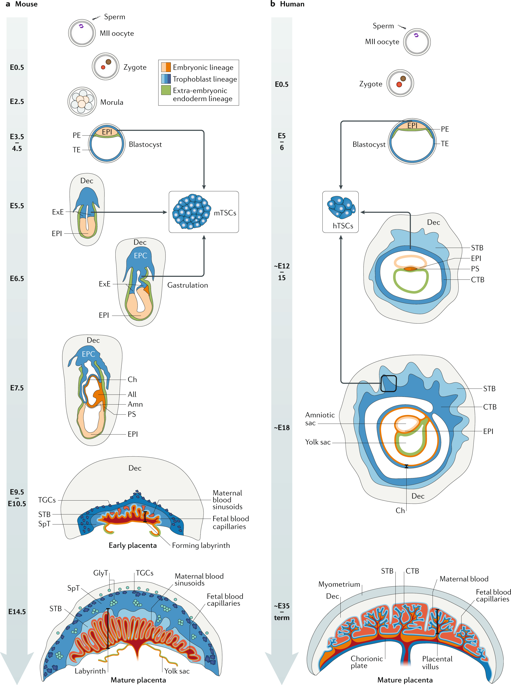当前位置:
X-MOL 学术
›
Nat. Rev. Genet.
›
论文详情
Our official English website, www.x-mol.net, welcomes your
feedback! (Note: you will need to create a separate account there.)
Mechanisms of early placental development in mouse and humans.
Nature Reviews Genetics ( IF 39.1 ) Pub Date : 2019-09-18 , DOI: 10.1038/s41576-019-0169-4 Myriam Hemberger 1, 2, 3, 4, 5 , Courtney W Hanna 4, 5 , Wendy Dean 1, 2, 4, 6
Nature Reviews Genetics ( IF 39.1 ) Pub Date : 2019-09-18 , DOI: 10.1038/s41576-019-0169-4 Myriam Hemberger 1, 2, 3, 4, 5 , Courtney W Hanna 4, 5 , Wendy Dean 1, 2, 4, 6
Affiliation

|
The importance of the placenta in supporting mammalian development has long been recognized, but our knowledge of the molecular, genetic and epigenetic requirements that underpin normal placentation has remained remarkably under-appreciated. Both the in vivo mouse model and in vitro-derived murine trophoblast stem cells have been invaluable research tools for gaining insights into these aspects of placental development and function, with recent studies starting to reshape our view of how a unique epigenetic environment contributes to trophoblast differentiation and placenta formation. These advances, together with recent successes in deriving human trophoblast stem cells, open up new and exciting prospects in basic and clinical settings that will help deepen our understanding of placental development and associated disorders of pregnancy.
中文翻译:

小鼠和人类早期胎盘发育的机制。
胎盘在支持哺乳动物发育方面的重要性早已得到认可,但我们对支持正常胎盘的分子、遗传和表观遗传要求的了解仍然被严重低估。体内小鼠模型和体外衍生的小鼠滋养层干细胞都是宝贵的研究工具,可用于深入了解胎盘发育和功能的这些方面,最近的研究开始重塑我们对独特的表观遗传环境如何促进滋养层分化的看法和胎盘形成。这些进展,连同最近在衍生人类滋养层干细胞方面取得的成功,在基础和临床环境中开辟了令人兴奋的新前景,这将有助于加深我们对胎盘发育和相关妊娠疾病的理解。
更新日期:2019-09-18
中文翻译:

小鼠和人类早期胎盘发育的机制。
胎盘在支持哺乳动物发育方面的重要性早已得到认可,但我们对支持正常胎盘的分子、遗传和表观遗传要求的了解仍然被严重低估。体内小鼠模型和体外衍生的小鼠滋养层干细胞都是宝贵的研究工具,可用于深入了解胎盘发育和功能的这些方面,最近的研究开始重塑我们对独特的表观遗传环境如何促进滋养层分化的看法和胎盘形成。这些进展,连同最近在衍生人类滋养层干细胞方面取得的成功,在基础和临床环境中开辟了令人兴奋的新前景,这将有助于加深我们对胎盘发育和相关妊娠疾病的理解。











































 京公网安备 11010802027423号
京公网安备 11010802027423号